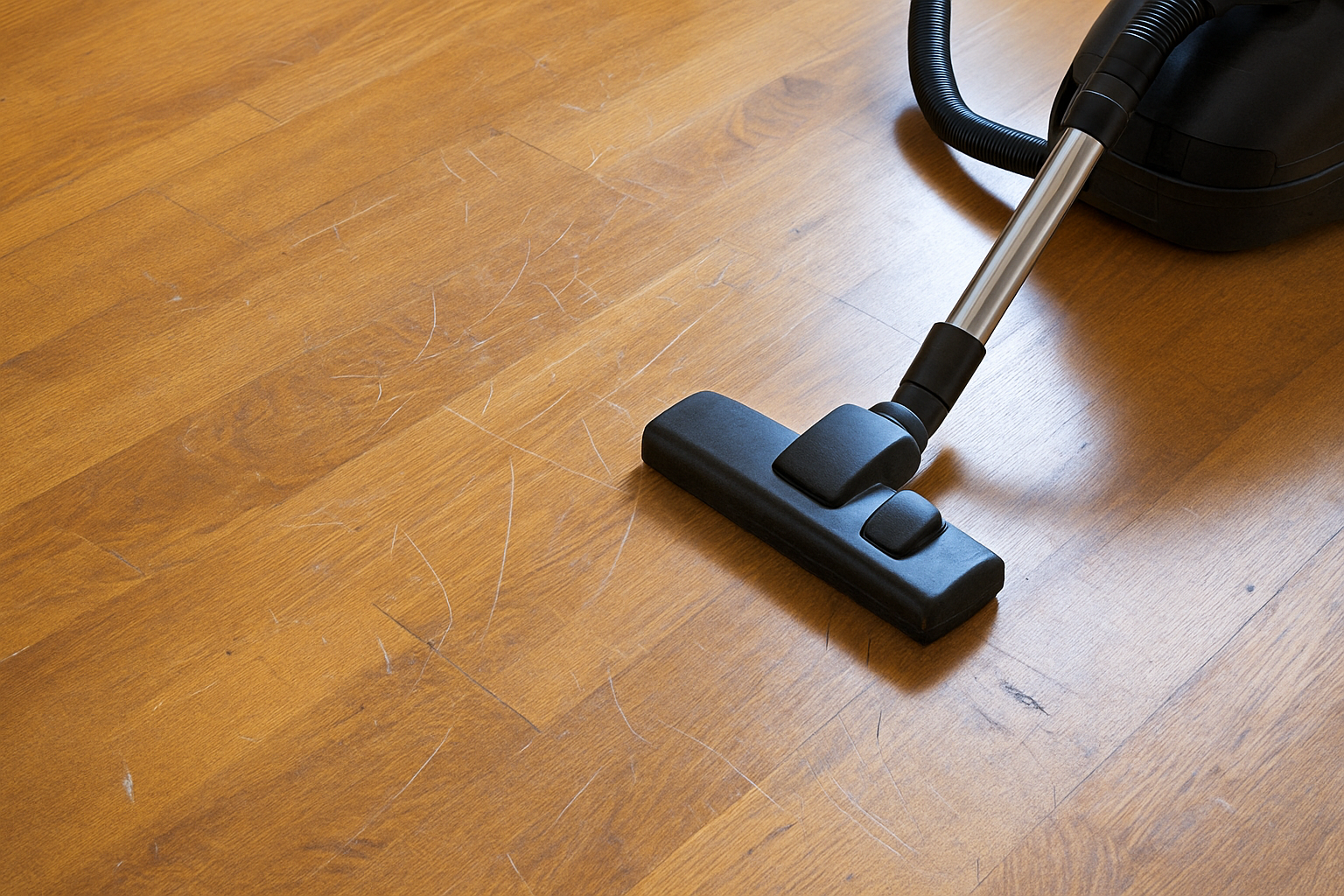
🌍 Introduction: A Common Complaint with Serious Implications
Across European and Middle Eastern markets, one of the most frequent after-sales complaints distributors hear is:
“The vacuum leaves fine scratches on hardwood floors.”
While these scratches might seem minor, they can cause major brand reputation and warranty challenges for procurement and distribution teams.
For vacuum cleaner manufacturers, R&D engineers, and B2B buyers, understanding why this happens—and how to prevent it—is key to reducing long-term costs and protecting product value.
🔬 Section 1: The Hidden Physics Behind Floor Scratches
Most scratches come not from the wood itself, but from contact dynamics between the vacuum head and floor surface.
1️⃣ Abrasive Brush Materials
Budget vacuums often use nylon bristles designed for carpets. On wood, these act like micro-sandpaper, leaving swirl marks.
2️⃣ Rigid Wheel Design
Plastic wheels may trap tiny dust particles that grind into the finish with each pass.
3️⃣ Excess Suction Pressure
High suction can create downward drag, pressing abrasive debris against the wood.
4️⃣ Poor Airflow Design
Improper airflow circulation lifts dust but re-deposits it near the edges, creating microabrasions over time.
Understanding these forces is essential for developing true hardwood-safe vacuum systems.
⚙️ Section 2: Engineering Insights — What Makes a Vacuum “Wood-Safe”
A wood-safe vacuum is not about weaker suction—it’s about controlled force distribution and smart materials.
1️⃣ Soft Contact Architecture
Microfiber roller brushes glide smoothly over delicate coatings, maintaining tight suction without friction.
2️⃣ Torque-Regulated Suction Control
Adaptive suction sensors reduce air pressure when reflective or low-friction surfaces are detected, protecting finishes.
3️⃣ Anti-Static, Non-Marking Wheels
Rubberized or thermoplastic elastomer (TPE) wheels prevent static buildup and scratching, while improving traction on polished floors.
4️⃣ Airflow Deflection System
Deflectors redirect side airflow inward to prevent edge dust abrasion—a key improvement for long-term surface integrity.
🧩 Section 3: Procurement-Level Impact — Protecting Brand and Margin
For B2B distributors, “scratch-free performance” means more than surface protection—it means brand preservation.
Each complaint or return erodes both reputation and margin.
Distributors who select hardwood-optimized vacuums reduce warranty claims, expand premium market appeal, and strengthen buyer confidence.
Key procurement advantages include:
📉 Lower after-sales costs
🏷️ Premium brand perception in EU & GCC markets
🔁 Simplified marketing: “Safe for all floors—tile, wood, and carpet”
In competitive procurement environments, these attributes directly affect bottom-line performance.
🧠 Section 4: Comparing Engineering Approaches
| Design Area | Common Mistake | Effect on Wood | Optimized Solution |
|---|---|---|---|
| Brush Material | Nylon or rigid fibers | Fine scratches | Soft microfiber brush |
| Wheel Material | Hard plastic | Grit dragging | Anti-static TPE wheels |
| Suction Control | Overpressure | Burnishing | Torque-regulated suction |
| Airflow Path | Unsealed edges | Edge abrasion | Guided deflection system |
Modern vacuums that integrate these improvements deliver high-efficiency cleaning without mechanical damage—a critical procurement differentiator.
💡 Section 5: Performance Without Compromise
Preventing scratches shouldn’t mean losing cleaning power.
A well-engineered vacuum balances airflow efficiency with surface sensitivity.
Key design features include:
Dual suction modes for hard and soft surfaces
Lightweight chassis (<5 kg) to reduce wheel pressure
Self-cleaning brushes that minimize debris friction
Optimized motor control for consistent suction with lower energy use
These advancements define the new generation of energy-saving wet dry vacuums built for both commercial and residential applications.
🧰 Section 6: Maintenance Practices for Long-Term Protection
Even the most advanced vacuums require proper maintenance to stay “floor-safe.”
Best practices for distributors and cleaning professionals include:
Replace brush heads every 3–6 months in heavy-use environments.
Clean wheel axles regularly to prevent grit accumulation.
Avoid generic aftermarket brushes—stiffness varies widely.
Train customers to use “hard floor mode” on sensitive surfaces.
Consistent maintenance ensures long-term performance and protects client satisfaction.
🌙 Section 7: Quiet Power — When Silence Meets Precision
Hardwood floors are often installed in luxury hotels, offices, and homes where noise reduction is essential.
Vacuum models featuring acoustic insulation chambers and vibration-dampened motor mounts maintain under 62 dB sound levels—quiet enough for night cleaning, powerful enough for daily operation.
For distributors, this combination offers dual positioning:
“Strong performance with whisper-level operation.”
🚀 Section 8: Building Trust Through Engineering Excellence
In modern vacuum cleaner procurement, product reliability equals long-term client retention.
Distributors who source poorly engineered vacuums risk warranty losses and brand fatigue.
High-quality vacuums designed for wood-floor compatibility ensure operational efficiency, customer confidence, and sustainable business growth.
Smart engineering is no longer optional—it’s a strategic investment in brand equity.
🧭 Conclusion: The Science of Surface Protection
Scratches on wooden floors are more than aesthetic—they’re financial and reputational risks.
By combining adaptive suction control, optimized materials, and precise airflow design, modern vacuums can achieve powerful yet gentle cleaning across all surfaces.
For procurement specialists and distributors, choosing a wood-safe vacuum system isn’t just a technical decision—it’s a statement of quality and reliability.
📌 Hashtags
vacuumsprocurement, vacuumcleanerdistribution, EnergySavingVacuum, EfficientPowerfulVacuumCleaner, WetDryVacuumCleaner, VacuumCleanerforHardwoodFloors, QuietVacuumforNightUse, HardwoodProtectionVacuum, AntiScratchVacuum, AdaptiveSuctionControl, TorqueRegulatedVacuum, SoftBrushVacuum, SmartVacuum, TPEWheelsVacuum, AntiStaticVacuum, FloorProtectionSystem, QuietPowerVacuum, CommercialVacuumCleaner, OEMVacuum, ODMVacuum, DistributorReadyVacuum, B2BCleaningSolutions, VacuumEngineering, FloorCareTechnology, HighEfficiencyVacuum, DustFiltrationTechnology, MultiSurfaceVacuum, WetDryVacuumTechnology, EnergySavingCleaner, ProfessionalVacuumEquipment, IntelligentVacuumCleaner, EcoFriendlyVacuum, HardwoodSafeVacuum, HotelCleaningVacuum, IndustrialVacuumSystem, FloorCareInnovation, GlobalVacuumProcurement, MultiFloorVacuum, SmartCleaningSystem, QuietVacuumCleaner, HeavyDutyVacuumCleaner, AdaptiveVacuumSystem, FloorProtectionTechnology, CleaningInnovation, OEMVacuumSupplier, ODMVacuumManufacturer, VacuumTechnology2025, NoiseReductionVacuum, HardwoodFloorSafety, SurfaceProtectionEngineering
















